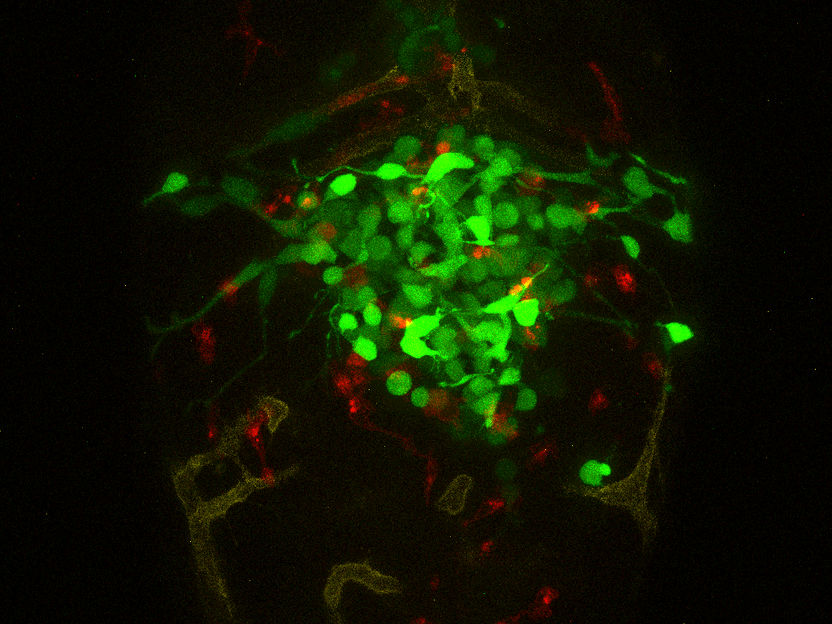Zebrafish “avatars” to help tailor glioblastoma therapies
Scientists have created a new zebrafish xenograft platform to screen for novel treatments for an aggressive brain tumor called glioblastoma
glioblastoma is an aggressive and difficult-to-treat brain tumor in adults. On average, patients survive for only 1.5 years. The standard of care treatment for this disease, which includes surgery followed by radiation and chemotherapy, has not changed in 18 years. That’s partly because the cancer is highly variable with many differences across the patient population. Secondly, these cancer cells also deceive the body in insidious ways: they even recruit immune cells called macrophages to help them. And thirdly, they are out of reach for most anti-cancer drugs, which have only a limited capacity to penetrate brain tissues. Besides the standard of care treatment, oncologists try out drugs on glioblastoma patients without any guarantee they’ll work, often involving adverse side effects.

Brain region of a zebrafish avatar bearing a human glioblastoma tumor: patient-derived tumor cells (green) growing in a zebrafish embryo with its vascular network labeled in yellow, and its macrophages, a type of immune cell, in red.
Lise Finotto, VIB – KU Leuven
“These patients really are in need of new therapies,” says Professor Holger Gerhardt, the senior author of the study and vice-Scientific Director of the Max Delbrück Center in Berlin. “It is very important to identify the patients who do respond to a specific treatment, and the ones who do not.”
Lise Finotto, the lead author and a cancer researcher at the VIB-KU Leuven Center for Cancer Biology in Belgium and formerly at the Max Delbrück Center, and her senior collaborators Gerhardt and Professor Frederik De Smet at KU Leuven, have created a screening platform that could be refined to find novel targets for drugs against glioblastoma. It could also be used to check if a particular patient will respond to a therapy. The study was published in “EMBO Molecular Medicine.”
To understand how macrophages can interact with glioblastoma cells of different patients, the researchers created zebrafish “avatars.” Gerhardt’s lab works extensively with zebrafish. These three-centimeter-long fish are considered good model organisms as their embryos are translucent, making it possible to monitor what’s happening inside.
An unexpected survival
Finotto investigated glioblastoma stem cells from seven patients collected by scientists at the De Smet lab, which is establishing a living tissue bank of glioblastoma samples. She injected them into zebrafish embryos, creating xenograft models – an avatar for each specific patient. When she live-imaged the embryos, it appeared that the glioblastoma cells had adapted well to their new environment. She saw the zebrafish’s immune system sending macrophages as part of an immune response to control the tumor. But as is typical in glioblastoma, the macrophages were suppressed. The tumors have several mechanisms to reprogram the macrophages so they help them grow.
"We wanted to learn how to revert the macrophages to a tumor-attacking state,” Finotto says. And a clue surfaced when they noticed that the tumor of one patient did not suppress the normal macrophage response.
“Upon closer investigation of the medical details, we discovered that this patient was what we call a 'long-term survivor’,” says De Smet at KU Leuven. “It’s a term used for glioblastoma patients with a survival of more than five years, which is exceptionally rare in this brain cancer.”
Testing platform
Their curiosity about the patient became the driving force behind the project, Finotto says. When they cultured the tumor cells and macrophages together and did single-cell RNA sequencing, they learned that one gene, LGALS1, was downregulated in the tumor of the long-term survivor compared to the others. Earlier studies have also shown that silencing of LGALS1 in glioblastoma cells can result in longer survival.
The scientists confirmed their results by knocking out the gene in another patient’s sample and observed in the zebrafish models that the tumor became less invasive.
This platform could be used to identify promising targets other than LGALS1 for the treatment of glioblastoma, Finotto says. And with some refinement, zebrafish avatars could be used to identify which treatments will work. Researchers could investigate whether the tumor cells from particular patients grafted into zebrafish respond when treated with various drugs to find the ones that lead to tumor regression, Gerhardt says.
“Armed with this information, we could inform oncologist and help them to make more supported treatment decisions for the patient,” De Smet says.
Original publication
Other news from the department science
Most read news
More news from our other portals
See the theme worlds for related content
Topic world Fluorescence microscopy
Fluorescence microscopy has revolutionized life sciences, biotechnology and pharmaceuticals. With its ability to visualize specific molecules and structures in cells and tissues through fluorescent markers, it offers unique insights at the molecular and cellular level. With its high sensitivity and resolution, fluorescence microscopy facilitates the understanding of complex biological processes and drives innovation in therapy and diagnostics.

Topic world Fluorescence microscopy
Fluorescence microscopy has revolutionized life sciences, biotechnology and pharmaceuticals. With its ability to visualize specific molecules and structures in cells and tissues through fluorescent markers, it offers unique insights at the molecular and cellular level. With its high sensitivity and resolution, fluorescence microscopy facilitates the understanding of complex biological processes and drives innovation in therapy and diagnostics.




















































